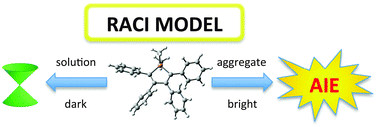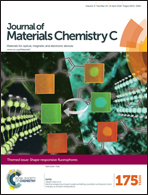Restricted access to a conical intersection to explain aggregation induced emission in dimethyl tetraphenylsilole†
Abstract
The mechanism behind aggregation induced emission (AIE) in the prototypical dimethyl tetraphenylsilole (DMTPS) molecule is investigated with ab initio calculations combining the CASSCF and CASPT2 methods with time-dependent DFT. DMTPS is AIE-active because it is strongly fluorescent in the aggregate phase but only weakly in solution. Based on the results, we introduce a restricted access to a conical intersection (RACI) model to explain AIE in DMTPS. According to the RACI model, excited DMTPS in solution can decay to the ground state because there is an energetically available conical intersection, and this explains the weak fluorescence observed experimentally. The reaction coordinate to the intersection involves mainly a twist of the silole ring and a flapping motion of the phenyl substituents. The behaviour in the aggregate phase is simulated by carrying out calculations of one excited DMTPS molecule embedded in a crystal. Because of steric effects, the conical intersection in the crystal is not accessible energetically, and the molecule fluoresces. Thus, the different energy required to access the conical intersection with the ground state in solution and in the crystal explains the AIE phenomenon. Our results are in good agreement with the experimental photophysical properties (absorption and emission wavelength) of DMTPS. They are also in line with recent experimental results for a phosphole analogue of DMTPS showing that fusion of a benzene ring to the phosphole ring increases the lifetime of the excited state in solution (F. Bu, E. Wang, Q. Peng, R. Hu, A. Qin, Z. Zhao and B. Z. Tang, Chem. – Eur. J., 2015, 21, 4440). The present work, together with our previous study on diphenyl dibenzofulvene (Q. Li and L. Blancafort, Chem. Commun., 2013, 49, 5966), suggests that RACI must be quite a general model to explain AIE in medium sized molecules. It is also consistent with the restriction of intramolecular motion (RIM) mechanism introduced recently to explain AIE, since the intramolecular motions responsible for AIE are those leading to the intersection. Knowledge of the reaction coordinate to access the intersection provides useful guidelines for the design of more efficient luminescent compounds.

- This article is part of the themed collections: 2016 Journal of Materials Chemistry C Hot Papers and Shape-Responsive Fluorophores

 Please wait while we load your content...
Please wait while we load your content...